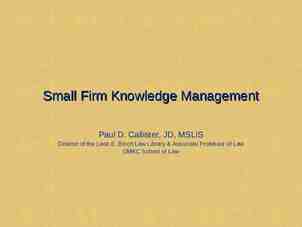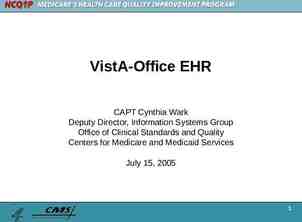Medical Parasitology Lab. Concentration techniques :Prepared By
18 Slides7.19 MB
Medical Parasitology Lab. Concentration techniques :Prepared By Mr. Raed Z. Ahmed Raed Z. Ahmed, Medical Parasitology Lab.,2012-2013
The microscopic examination of feces is required for the recognition and identification of intestinal parasites: 1. Direct Microscopy: Advantages Useful for the observation of motile protozoan trophozoites. Disadvantages May not detect ova, cysts and larvae which are present in scant numbers. Raed Z. Ahmed, Medical Parasitology Lab.,2012-2013
2. Concentration techniques : Advantages Maximizes the numbers of organisms detected which may be too scanty to be seen by direct microscopy alone. Worm eggs, larvae, and protozoan cysts may be recovered. Disadvantages Destroys trophozoite stages. Most concentration methods destroy trophozoites stages. The purpose of concentrating feces is to increase possibility to finding ova, cyst, or larvae in samples that not be able to seen by direct microscopy. Raed Z. Ahmed, Medical Parasitology Lab.,2012-2013
Concentration Methods 1. Sedimentation method Modified Formal- Ether sedimentation technique Acid- Ether sedimentation technique 2. Flotation method Saturated Salt Solution technique Sheather’s Sugar Centrifugal Flotation technique Zinc Sulphate Centrifugal Flotation technique Raed Z. Ahmed, Medical Parasitology Lab.,2012-2013
Sedimentation Methods MODIFIED FORMAL- ETHER SEDIMENTATION Raed Z. Ahmed, Medical Parasitology Lab.,2012-2013
Modified Formal- Ether Sedimentation Formalin- Ether or Formalin- Ethyl acetate method is the recommended concentration procedures. Most types of worm eggs (round worms, tapeworms, schistosomes, and other fluke eggs), larvae, and protozoan cysts may be recovered by this method. Advantages: 1. Speed: one sample can be processed in 5 minutes. 2. Broad spectrum: it will recover most ova, cyst and larvae. 3. The morphology of most parasites is retained for easy identification. Disadvantages: 1. Requires several pieces of apparatus which does not make it an easy. 2. The preparation contains some debris. 3. Ether is flammable. Formalin is an irritant. 4. Hymenolepis nana and Fasciola spp. do not concentrate well. Raed Z. Ahmed, Medical Parasitology Lab.,2012-2013
Materials and Method Libra Applicator stick Glass centrifugal tubes Beaker Wire sieve Vortex or whirlimixer Centrifuge. Reagent: Reagent I: 10% formalin solution in distilled water. Reagent II: diethyl ether or ethyl acetate. Raed Z. Ahmed, Medical Parasitology Lab.,2012-2013
Procedures 1. Emulsify 1 gm. of feces in 7 ml of 10% formalin in a centrifuge tube. 2. Strain the suspension through a brass wire sieve, and collect in beaker. 3. Pour the filtrate into a 15 ml boiling tube and add 3 ml of ether, then mix well 15 sec on vortex or whirlimixer or 1 min by hand. 4. Transfer the ether- formalin suspension back into the washed centrifuge tube, and centrifuge at 3,000 rpm for 1 min. Raed Z. Ahmed, Medical Parasitology Lab.,2012-2013
Procedures (cont.) 5. Loosen the fatty layer and debris at the top of the tube with an applicator stick and invert the tube quickly to discard the supernatant. 6. On righting the tube, a few drops only should remain with the sediment, mix the sediment well and transfer one drops onto a glass slide and cover it with coverslip. 7. Scan the whole coverslip using 10x objective, turning into 40x for confirmation of identification of parasites. Raed Z. Ahmed, Medical Parasitology Lab.,2012-2013
Sedimentation Methods ACID- ETHER SEDIMENTATION TECHNIQUE Raed Z. Ahmed, Medical Parasitology Lab.,2012-2013
Materials and Method Libra Applicator stick Glass centrifugal tubes Beaker Wire sieve Vortex or whirlimixer Centrifuge. Reagent: Reagent I: 15% Hydrochloric acid. Conc. HCl 40 ml 60 ml Distilled water. Reagent II: diethyl ether or ethyl acetate. Raed Z. Ahmed, Medical Parasitology Lab.,2012-2013
Procedures 1. Mix thoroughly 1 gm. feces with 3 ml of 15% of hydrochloric acid and then mix well. 2. Add and additional 5-6 ml of 15% HCl and mix. 3. Strain the suspension through a wire sieve into beaker. 4. Place suspension in a glass centrifuge tube and make up to the 10 ml with distilled water. 5. Add 4 ml of ether, stopper the tube and shake vigorously 20 -30 sec using vortex. Raed Z. Ahmed, Medical Parasitology Lab.,2012-2013
Procedures (cont.) 6. Centrifuge 2-3 min at 1500 rpm, the suspension now will be layered. 7. Loosen plug of debris with applicator stick and immediately pour off liquid. 8. Transfer one drops onto a glass slide and cover it with coverslip. 9. Scan the whole coverslip using 10x objective, turning into 40x for confirmation of identification of parasites. Raed Z. Ahmed, Medical Parasitology Lab.,2012-2013
Intestinal Protozoa Giardia lamblia Raed Z. Ahmed, Medical Parasitology Lab.,2012-2013
Giardia lamblia It is the most common flagellate of the intestinal tract that cause giardiasis, Traveler's diarrhea. There is two diagnostic stages for Giardia lamblia : 1. Cyst is oval measuring 11 – 14u in length and 7 to 10 µm in width with 4 nuclei and remnant flagella, and it’s the infective stage. 2. Trophozoite is described as having a 'tear-drop' shape and are 10 to 20 µm long and 5 to 10 µm wide. The trophozoites contain two nuclei, four pair of flagella. (motility by flagella). Diagnosis: – Stool examination to see cyst stage, or trophozoite stage if the sample is fresh. Raed Z. Ahmed, Medical Parasitology Lab.,2012-2013
Life cycle Raed Z. Ahmed, Medical Parasitology Lab.,2012-2013
Giardia lamblia cyst Raed Z. Ahmed, Medical Parasitology Lab.,2012-2013
Giardia lamblia Trophozoite Raed Z. Ahmed, Medical Parasitology Lab.,2012-2013























